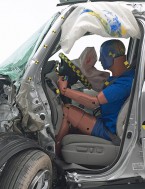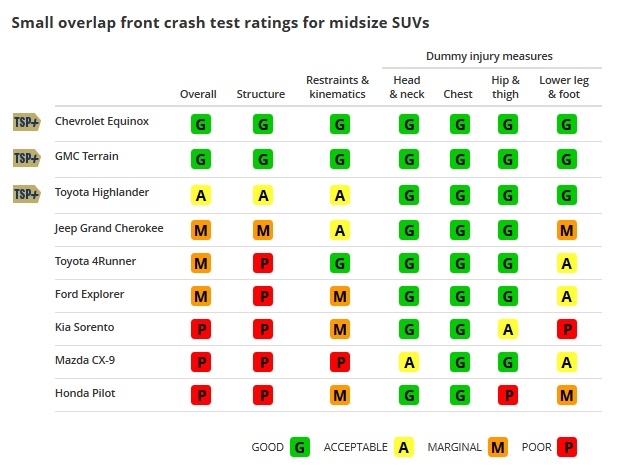
Today IIHS released the latest testing result for 9 midsize SUV models.
Two GM SUVs earned a “Good” ratings. From the IIHS released vedio, during the crash test these two SUVs (Chevrolet Equinox, GMC Terrain) use the strategy of “sliding pass” the crash object, prevent the direct impact to the occupant safety cage. In several past tests, Volvo also use the similar methods to earn a “Good” rating.
The Toyota Highlander, which earned an “Acceptable” rating, uses the strategy that the engine compartment absorbs part of the impact energy, and the occupant safety cage (especially the driver side A pillar) has direct impact with the crash object, and the A pillar withheld the impact force and maintained safety space reasonably well.
The Jeep Grand Cherokee got a “Marginal” rating. During the crash testing, the occupant safety cage and A pillar has direct impact with the crash object. The deformation is not bad, but it is the design of the parking brake, safety belt and the airbag pose great risk for the driver.
The Toyota 4Runner also got a “Marginal” rating. Its safety cage situation is similar to the Grand Cherokee; but one thing we should note that, the 4Runner is the only body-on-frame SUV in this test. Body-on-frame SUV has large mass in the car frame, and there is no structural stress applied to the occupant compartment, which means if you want to make the body-on-frame SUV’s occupant compartment as strong as other unibody SUVs, it will be weight much heavier than those SUVs.
The Ford Explorer has a “Marginal” rating as well. The safety cage has considerable deformation, and the design of the airbags does not protect the driver well.
The Kia Sorento got the lowest rating. Its situation is somewhat similar to the Ford Explorer, just the safety cage deformation is more excessive than the Explorer, and the airbags barely protect the driver (the side airbag even did not deploy).
The Mazda CX9 is even worse than the Sorento, which the driver’s head has direct contact with the front door frame.
Finally, the Honda Pilot’s result comes with a big surprise. From my impression, Honda cars generally perform very well in the small overlap test, including the Accord, Civic and even the Odyssey minivan. Isn’t Honda R&D use the same safety principles to design its products? Or is it a case-by-case scenario? Or it is just coincident that some are doing well and some do not? Anyway, one thing we are sure is that, all vehicles designed AFTER IIHS had announced the small overlap test standards, should take this into consideration. The Honda Pilot was designed back in 2009 and there is no such test then, so that may be an excuse.




Recent Comments